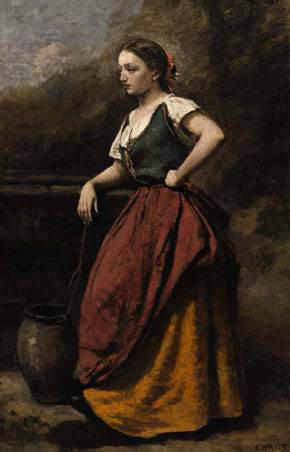
The Albright-Knox Art Gallery
Sotheby’s to offer a restituted painting by Jean-Baptiste-Camille Corot
On Wednesday, June 2, 2010, Sotheby’s London will offer for sale one of the finest figure paintings by Jean-Baptiste-Camille Corot (1796-1875) ever to have appeared on the market. Estimated at £800,000-1,200,000,Jeune femme à la fontaine enjoyed an exceptional early provenance before it was requisitioned during the Nazi period.It has now been restituted to the heirs of its erstwhile owners and will be one of the centrepieces of Sotheby’sforthcoming sale of 19th Century European Paintings.
]]>
March 13 2010, source: Sotheby’s
Jeune femme à la fontaine’s journey through history provides a story that is as compelling as those behind therestituted works by Gustav Klimt and Hendrick Goltzius recently sold at Sotheby’s.** The first owner was ErnestHoschedé (d. 1891), an important early patron of Claude Monet, from whom he commissioned decorative panels forhis residence just south of Paris, the Château de Rottembourg in Montgeron. Following financial difficulties, theHoschedé family moved into a house in Vétheuil with Monet, his wife Camille and his children. Hoschedé’s wife, Alice,eventually married Monet following their respective spouses’ deaths.
The second owner was Charles Alluaud (1861-1949), scion of the family that had directed the porcelain factory inLimoges since the eighteenth century. During his childhood, he and his brother, Eugène, had received paintinginstruction from Corot himself and it is likely that this relationship led to Alluaud’s acquisition of the present work.The next documented owner of Jeune femme à la fontaine is Eduard Ludwig Behrens, senior who was born inHamburg in 1824 and had been one of the early directors of the city’s private banking firm of Levy Behrens & Söhne.He acquired the painting in 1889. Upon his death he bequeathed his large and important art collection to his sonEduard Ludwig Behrens, junior, who left it, in turn, to his son Georg.
In 1925, Georg lent the Behrens’ paintings collection to the city of Hamburg for a period of ten years. On the expiryof this agreement, Georg attempted to send the collection to the safety of Switzerland, but was informed on 1st April1935 by the Nazi authorities that the present work and a number of other key works from the Behrens collection hadbeen included on the Verzeichnis der national wertvollen Kunstwerke (list of works considered to be of nationalsignificance).
In May 1938, the Behrens banking firm was Aryanised and the following November Georg was arrested in Hamburgand then sent to the Sachsenhausen concentration camp where he was interned until the end of December. He thenemigrated to Belgium in April 1939. In order to obtain his exit visa he had to pawn all of his possessions to the State.From Belgium he moved to France where, following the outbreak of the Second World War, he was interned in acamp in the south of France. In the autumn of 1940 he obtained a visa for Cuba where he finally found his freedom.After the war, Georg Eduard Behrens returned to Hamburg and died in that city in 1956, never having recovered theCorot.
In 1941 the painting surfaced under the auspices of Berlin art dealer H.W. Lange. Shortly thereafter, Lange purchasedthe work for the Kröller-Müller Museum in Otterlo using money from a fund set up in 1941 by the Nazis. The purposeof the fund was to help the museum purchase new works for its collection after three of its paintings, by Lucas Cranachthe Elder, Hans Baldung Grien and Barthel Bruyn the Elder, had been requisitioned for display in the Führermuseum inLinz. The fund was in effect a smokescreen to give the impression that this was an exchange rather than theconfiscation it really was.
In 1998, in response to an initiative by the Netherlands Museum Association, the museum attempted to trace theorigins of various works acquired during the period 1940-1948. Following considerable research conducted by therepresentatives of the heirs, it was confirmed that the original owner parted with the work involuntarily and, as a result,the Minister of Education, Culture and Science decreed that Jeune femme à la fontaine be returned to the heirs ofGeorg Eduard Behrens in 2008 after 66 years in the museum’s collection. Sotheby’s sale will allow collectors theopportunity to provide the next chapter in the painting’s history.
Jeune femme à la fontaine can be ranked among Corot’s finest figure paintings of the 1860s and 1870s. The classicalpose and modelling of the figure evoke the iconic female figures of Renaissance masters Leonardo and Raphael. It wasduring and following trips to Italy in the 1820s, 1830s and 1840s that Corot was inspired to create his series of Italianpeasant girls. While the present work was painted decades after these sojourns, it was certainly painted from the artist’sidealised memories of the Italian women he encountered, and is imbued with a melancholy and pensive intimacy.
Follow us on:

